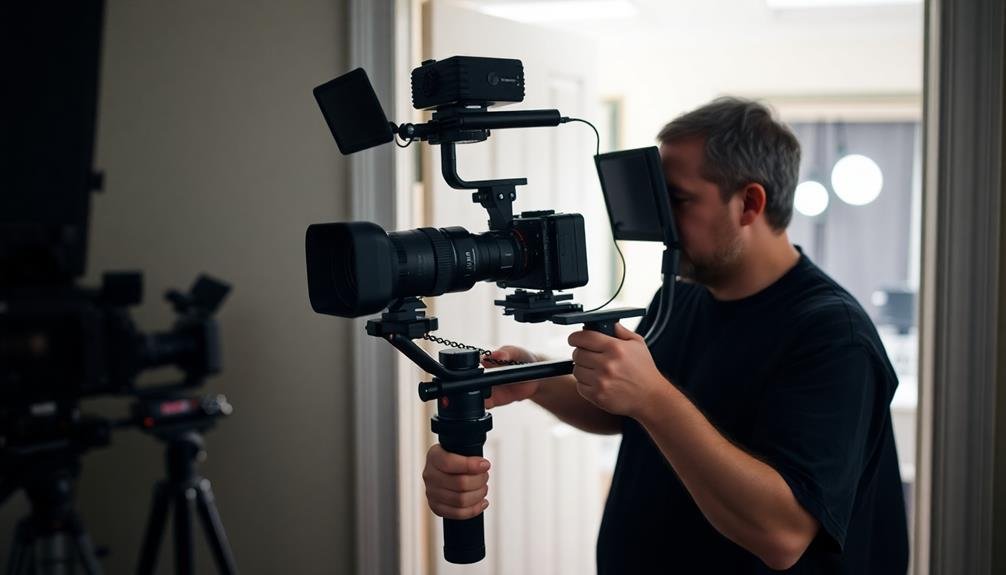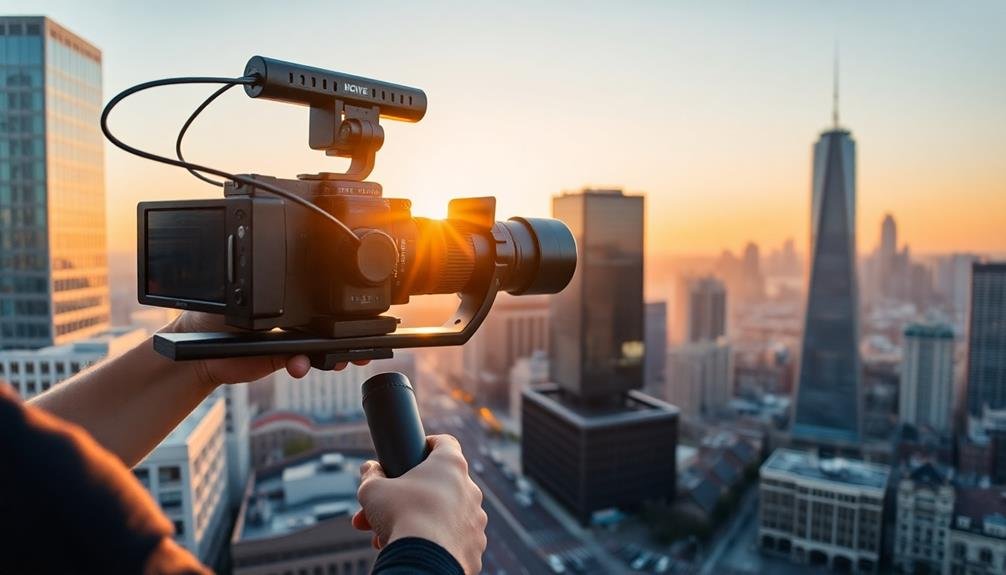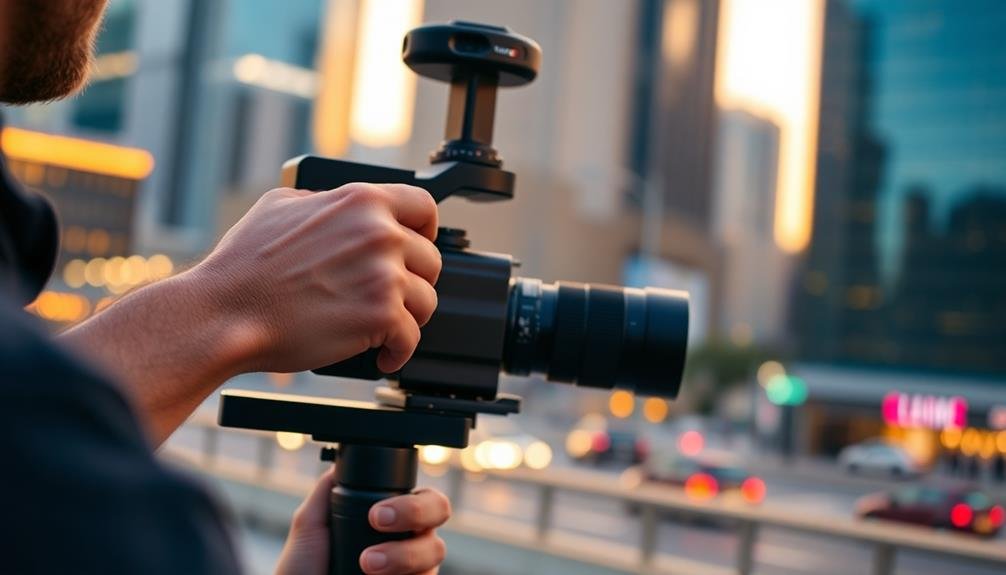To achieve silky-smooth gimbal shots, master these three pro techniques. First, perfect the counterbalance technique by adjusting your camera's position on all axes for ideal stability. Second, refine your pan and tilt movements, practicing fluid horizontal and vertical motions at consistent speeds. Finally, enhance your gimbal settings by fine-tuning motor strength, follow speed, and deadband to prevent vibrations and jitter. Regular calibration and experimentation with different profiles will guarantee peak performance. By honing these skills, you'll transform shaky footage into cinematic masterpieces. Dive deeper to access the full potential of your gimbal and elevate your videography to new heights.
Master the Counterbalance Technique

Balancing your gimbal is the foundation of achieving silky-smooth shots. The counterbalance technique is essential for maintaining stability and preventing unwanted movement during filming.
To master this technique, start by mounting your camera on the gimbal and adjusting the horizontal and vertical axes until the camera remains level when you let go.
Next, fine-tune the roll axis to guarantee the camera stays perfectly horizontal. Once you've achieved basic balance, it's time to perfect the counterbalance. Slightly tilt the camera forward and backward, observing how it responds. Adjust the counterbalance until the camera stays in place at any angle.
Remember, different lenses and accessories can affect your camera's weight distribution, so you'll need to rebalance whenever you change your setup. Practice this technique regularly to develop muscle memory and speed up your balancing process on set.
Don't rush through this step – a well-balanced gimbal will greatly reduce the strain on the motors, extend battery life, and produce smoother footage.
With consistent practice, you'll be able to quickly achieve perfect balance, allowing you to focus on capturing those cinematic, silky-smooth shots that'll elevate your videography.
Perfect Your Pan and Tilt

Now that you've mastered balancing, it's time to focus on two fundamental gimbal movements: panning and tilting. These techniques allow you to create smooth, cinematic shots that elevate your video production.
For panning, start by loosening the pan axis. Practice moving the gimbal horizontally at a consistent speed. Begin slowly and gradually increase your pace. Keep your movements fluid and avoid sudden starts or stops. Use visual markers in your environment to maintain a steady pace throughout the pan.
Tilting requires a similar approach. Loosen the tilt axis and practice moving the camera vertically. Maintain a constant speed and use your whole body to create smooth tilts. Keep your arms close to your body for stability.
Combine panning and tilting for more dynamic shots. Start with simple movements before attempting complex combinations. Always keep your subject in frame and maintain proper composition throughout the motion.
Practice these techniques regularly to build muscle memory. Experiment with different speeds and angles to find what works best for your style and subject matter.
Optimize Gimbal Settings for Smoothness

To achieve silky-smooth shots, you'll need to enhance your gimbal's settings. Start by adjusting the motor strength for each axis. You want just enough power to stabilize your camera without introducing unwanted vibrations.
Next, fine-tune the follow speed and deadband settings. A slower follow speed often results in smoother movements, while a slightly wider deadband can prevent small, jittery adjustments.
Experiment with different profiles for various shooting scenarios:
- Slow and steady for cinematic shots
- Quick and responsive for action sequences
- Balanced for general-purpose filming
- Custom settings for specific creative effects
Don't forget to calibrate your gimbal regularly, especially when changing camera setups or shooting in different environments. This guarantees peak performance and helps maintain smooth motion.
Frequently Asked Questions
How Do I Choose the Right Gimbal for My Camera Setup?
To choose the right gimbal, consider your camera's weight and size. Check the gimbal's payload capacity and compatibility. Think about your shooting style and needed features. Don't forget to factor in your budget and portability requirements.
What's the Best Way to Transport and Store a Gimbal Safely?
To transport and store your gimbal safely, you'll want to use a padded case or bag designed for gimbals. Keep it in a cool, dry place. Don't forget to remove the batteries and secure all loose parts before storage.
Can I Use a Gimbal for Time-Lapse or Hyperlapse Photography?
Yes, you can use a gimbal for time-lapse and hyperlapse photography. It'll stabilize your camera, creating smooth motion and consistent framing. You'll need to set up your camera's interval shooting and program the gimbal's movement for best results.
How Often Should I Calibrate My Gimbal for Optimal Performance?
You should calibrate your gimbal regularly, ideally before each shoot. If you notice any instability or drift, recalibrate immediately. It's also wise to calibrate after travel or significant temperature changes. Don't skip this vital step!
Are There Any Accessories That Can Enhance Gimbal Stability and Functionality?
You'll find several accessories to boost your gimbal's performance. Consider counterweights for balance, extension poles for reach, and quick-release plates for efficiency. Don't forget external monitors and follow focus systems for enhanced control and precision.
In Summary
You've now learned three pro techniques to elevate your gimbal shots. By mastering the counterbalance technique, perfecting your pan and tilt, and optimizing your gimbal settings, you'll create silky-smooth footage that'll impress your audience. Remember, practice makes perfect. Don't be afraid to experiment with these methods and find what works best for your style. With time and dedication, you'll be capturing cinematic shots like a pro in no time.

As educators and advocates for responsible drone use, we’re committed to sharing our knowledge and expertise with aspiring aerial photographers.




Leave a Reply